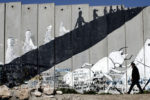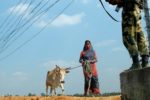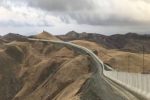Whither Cosmopolis: Yearning for Closure in Times of Uncertainty
The world, after 11 September 2001, has been fracturing as, in direct contradiction to the liberal ethos of openness, a series of nations have reverted to immuring themselves in a context of increased migratory flows and populist animosity. While the world counted 16 walls at the beginning of the 21st century, today there are 53 walls totalling 40,000 kilometres in length.
Walls are an anthropological constant. They epitomise human finitude. Our cells have walls and our bodies an epidermal envelope separating us from the outside world. Our language and cognition are delimited by semantic walls and conceptual containers. Economically, enclosures fostered the Industrial Revolution. Sociologically, walls and fences have proven crucial as material and symbolic sites of inclusion and exclusion*. The key dyad of ingroup (cohesion) vs. outgroup (hostility) has been, for better or worse, structuring human communities since the dawn of mankind.
Despite the early cosmopolitan utopias of the Greek and Roman Stoics, walls are omnipresent in, and perhaps constitutive of, human history. Since the Neolithic, walls have been integral to the major modes of human political organisation, most notably as defensive structures. Empires used walls as civilisational markers and to regulate commercial flows. Medieval cities, like their antique forebears, walled themselves in behind massive bulwarks for protection. Nation-states, finally, built military fortifications such as the French Maginot Line in an effort to buttress their “natural” frontiers.
The Materiality of Walls
As constitutive as they are for humans, walls entail a host of pernicious effects. They divide, segregate, reify and exclude. They reinforce the fault line between the privileged on the one hand and the marginalised and the undesirables on the other. Walls unleash new forms of – frequently lethal – violence. They produce envy about what may be found on the other side. Walls force migrants to pursue more dangerous and costly routes or prevent them from returning to their home country. They hamper the circulation of fauna, flora and water flows. Walls, finally, put human rights out of reach of those who need them most.
Walls are physical, material objects with a visual identity and a life of their own.They range from the porous (e.g. mere berms or fences) to the seemingly impermeable (e.g., multiple ranges of concrete walls equipped with tunnel and movement detectors, drones, night-vision equipment, floodlights and robots). But despite all their materiality, walls are also, above all, mental constructions. The Great Wall of China, the Korean demilitarised zone or the Iron Curtain have profoundly shaped our collective memories. In a sense, physical walls only exist in continuity with the walls in our minds – perhaps in a dialectic relationship with them. Recently, more immaterial types of walls have been emerging in the digital realm such as “gateways”, “blockchains” or the Great Firewall of China.
The Vanishing Prospect of a Borderless World
In the seemingly “borderless” world of the (post)-modern/global era characterised by endless fluidity walls appear as something of an oddity, a relic of an ancient past. With the fall of the Iron Curtain, so the hope went, smaller walls would fall too. However, in the last two decades the exact opposite took place: around 30 nations have built 43 new barriers along their borders with 31 other countries (see map). “Gated communities”, signalling new forms of social apartheid in urban settings, have been springing up in Brazil, South Africa, Egypt, Iraq and elsewhere. Internationally, the list of most prolific wall-builders includes India, Israel, Saudi Arabia, Uzbekistan, Turkey and many European countries such as Hungary, Greece and Bulgaria. The United States and its president’s grandiloquent talk of a great and beautiful wall with Mexico further nurture this “International of Walls”.
The Roots of Walls
Walls, today, are usually built for a mixture of reasons combining security – mostly against terrorism — and migratory concerns, with an emphasis on the latter. If one looks at the longue durée, it rapidly appears that while in the past walls were built primarily to keep hostile aggressors at bay, today their main purpose is to keep out migrants and refugees seeking shelter and opportunities for a better life.
Walls therefore firstly reflect the general anxiety in face of intensifying migration and raising global inequality. Cross-border economic inequality now constitutes the most robust predictor of border walls.** Without surprise, in times of crises people shut their doors (and blinds) and revert to truisms such as “the boat is full”. Walls, which are usually built for those on the inside, offer mental comfort. They reassure.
Secondly, the new walls are also the symptom, the very flesh-and-bone manifestation of the rise of right-wing populism with its fears of various types of “contamination”, false certainties and identitarian illusions.
Thirdly, constructing walls is a lucrative business for a well-organised and influential cottage industry. It has been estimated, for instance, that one kilometre of the US-Mexico border costs between USD 1 and 6 million to build and USD 6.5 billion to operate over 20 years.***
Fourthly, the new walls have been attributed to a regained vitality of sovereignty and confidence in the territorial state. Conversely, however, it has also been argued that they constitute a vain and desperate attempt to veil the incapacity of states to address terrorist and other global threats.
The Theatricality of Walls
 One of the works of street art painted on what remains of the Berlin wall on the occasion of the 25 years of its fall.
One of the works of street art painted on what remains of the Berlin wall on the occasion of the 25 years of its fall.A wide range of political actors have indeed used the symbolic capital of walls to “look tough”, to project myths of origin and ethnic purity, and to mask more prosaic intentions. Walls, in this sense, have become a dramaturgic act – a show where various actors vie for the attention of an ever more ephemeral and fickle public. Beyond the rhetoric, however, it is much less evident that the new walls prove effective. In practice, walls often remain the product of improvisation and makeshift. In the era of airplanes, drones and heavy artillery, walls have lost their military relevance just as they largely fail to keep out terrorists.
Experts are also sceptical about whether walls adequately curb migration as most borders are simply too long and topographically uneven to be patrolled efficiently. All walls remain, ultimately, porous and ephemeral. They can be circumvented, tunnelled, crossed with ladders or ramps, or flown over. Most migrants, nowadays, as is the case in the United States, do not pass through clandestine border crossings but through official points of entry such as airports. From such a perspective, walls mostly divert or canalise flows but do not prevent them from occurring.
The Praxeology of Walls
Whatever their ultimate efficiency, walls – far from simply freezing the status quo – have real impacts. Walls have become a dramaturgic act – a show where various actors vie for the attention of an ever more fickle public They create new borderland ecosystems and trigger strategies of circumvention, appropriation and subversion. They attract economic entrepreneurs such as smugglers, drug couriers, human traffickers and cattle rustlers. They provide employment to border patrols and personnel and give a sense of purpose to the militias professedly defending it. For borderlanders living in the messy reality of “liminal spaces”, walls are lived experiences and part of their identities. Recent scholarship has therefore drawn a more nuanced picture of walls, highlighting their capacity to foster opportunities, to act as catalysts of (ex)change and as vectors for aesthetic transgression such as graffiti.
To conclude, the German philosopher Johann Gottfried Herder once suggested that closure is good in young nations for purposes of identity formation but that mature ones were bound to openness, exchange and dialogue. Even though everything in human life is finite, except, perhaps, the universe, and walls prove to be constitutive of – and necessary to – communal life and social organisation, it remains, after all, the mission of humanity to transcend them.
The present dossier aims to offer a better understanding and fresh perspectives on a series of walls and fences – new and old – between nations.
-
1
 A Contagious Craze for Walls
A Contagious Craze for WallsHistory shows that countries, cities and communities have always sought to shield themselves from the Other. However, for Professor Jean-François Bayart the contemporary craze for walls, rooted in the desire to partition people and work and to globalise everything else, is also breaking apart societies from within, giving rise to unprecedented dangers.
-
2
 The “Great Wall” of America: Historical Opportunities
The “Great Wall” of America: Historical OpportunitiesUS President Trump’s wall project has outraged Mexican public opinion, and yet man-made barriers between Mexico and the US have existed long before he came into power. Samuel Segura Cobos sees in the wall – certainly the product of Western liberalism – an opportunity for both countries to re-examine their relation as a more diverse world order emerges.
-
3
 Between Security and Apartheid: Cinematic Representations of the West Bank Wall
Between Security and Apartheid: Cinematic Representations of the West Bank WallThe West Bank Wall has become dramatically popular in many Palestinian and some Israeli films. It is now an object of study and a way to understand the different perceptions of the conflict, as explained by Ricardo Bocco.
-
4
 Battle of Identities at the India-Bangladesh Border
Battle of Identities at the India-Bangladesh BorderThe influx of Bangladeshi migrants in the Indian north-eastern state of Assam led to major ethnic backlash in the late 1970s, followed by India’s construction of fences along its border with Bangladesh. Anuradha Sen Mookerjee underlines the politisation of the border for electoral and governmental purposes.
-
5
 Turkey and the Middle-East: From Imperial Temptation to National Closure
Turkey and the Middle-East: From Imperial Temptation to National ClosureIn the early 2010s, Turkey launched a “Neo-Ottoman” diplomacy which, capitalising on the Arab Spring, was to restore Turkey’s status as a leader in the Middle East. For Özcan Yilmaz, the recent 764-kilometre-long wall along the Syrian border symbolises the regional rivalries and questions of identity that have put paid to Neo-Ottomanism.
-
6
 Combating Terrorism on the Somalian Border: The Improbable Kenyan Dream?
Combating Terrorism on the Somalian Border: The Improbable Kenyan Dream?In 2015, Kenya announced the construction of a 700-kilometre-long wall along its border with Somalia. Under the pretext of fighting the Shabaab, it aimed to stop the flow of Somali refugees. Today, only 8 kilometres have been built. Marc Galvin explores the history and reasons – official and non-official – behind this gap between dream and reality.
-
7
 Korea: Comfortable Wall, Uncomfortable Peace
Korea: Comfortable Wall, Uncomfortable PeaceIn 1953 the Korean Demilitarised Zone was established. Its defensive architecture has led to the gradual construction of a collective “us versus them” narrative, deeply engraved into public perception. In April 2018, however, Kim Jong Un and Moon Jae-in stepped over the demarcation line hand in hand to sign a peace declaration. For Emilia S. Heo, both North and South Koreans are faced today with new information, new stories and a new reality that will reshape their visions of the DMZ and how to transcend it.
Increasing Number of Walls in the World, 1945–2018
Based on Samuel Granados, Zoeann Murphy, Kevin Schaul and Anthony Faiola, “Raising Barriers: A New Age of Walls”, The Washington Post, 12 October 2016.
United States/Mexico
India/Bangladesh
Kenya/Somalia
South Korea/North Korea
Turkey/Syria
Israeli West Bank Barrier
1,120 km between California and Texas, around a third of the total border length of 3,141 km.
Origins
- In 1994, US Border Patrol installed sensors and stronger fencing in San Diego, California, and El Paso, Texas. In the fall of 2006, the Congress authorised the construction of 700 miles of fencing in rural areas in California and Arizona. In January 2017, President Trump signed an Executive Order to begin the extension of the border wall.
The fence covers 3,200 km of the 4,096.7-km-long border
Origins
- The fence finds its origin in the Assam Accord of 1985 signed between representatives of the Government of India and the leaders of the sub-national Assam Movement. The accord accommodated the claims of the Assam Movement to keep out irregular migrants. The construction of the fence started in 1993.
8 km already done of the 700-km-long project
Origins
- Following the siege of Garissa University in 2015, the Kenyan government announced the construction of the wall.
- Project stopped in January 2018 to open negotiations with the Somalian Government.
764-km-long wall
Origins
- In March 2015, Turkey closed its border with Syria.
- In August 2015, the first section of the border wall was constructed in Reyhanli.
- The wall was completed in June 2018.
The DMZ is 250 km (160 miles) long and about 4 km (2.5 miles) wide.
Origins
- In the Armistice Agreement of 27 July 1953, the DMZ was created as each side agreed to move their troops 2,000 m (2,200 yards) back from the front line, creating a 4-km-wide (2.5-mi-wide) buffer zone.
700 km.
Origins
- The barrier was built in 2002, during the Second Intifada that had begun in September 2000, and was officially justified by the Israeli need of security against the wave of violence.
Definition of “Wall”
"The English word ‘wall’ is derived from the Latin vallus meaning a ‘stake’ or 'post’ and designated the wood-stake and earth palisade which formed the outer edge of a fortification. Walls have traditionally been built for defense, privacy, and to protect the people of a certain region from the influence or perceived danger posed by outsiders” (from Joshua J. Mark, Ancient History Encyclopedia, https://www.ancient.eu/wall/).
Walls are social constructions that are often used in a metaphorical sense, serving as canvas to cultural and/or political projections. An example in point is the 1979 album The Wall of the progressive/psychedelic rock band Pink Floyd. Physical walls are the offspring of our mental walls but physical walls, in turn, also impact our mental maps and the way we configure spatial identities and alterity.
In academic terms, walls have further been described as “an exercise in verticality” (Carl Nightingale), as “top-down controlled sluices of human movement, points of banishment, and perfect locations for tax collection” (Carl Nightingale), as “material things with symbolic meaning” (Tamar Herzog) and, finally, as “sites of negotiation and practice-making or -following” (Tamar Herzog).
All quotes from Suzanne Conklin Akbari, Tamar Herzog, Daniel Jütte, Carl Nightingale, William Rankin and Keren Weitzberg, “AHR Conversation: Walls, Borders, and Boundaries in World History”, American Historical Review 122, no. 5 (2017): 1501–1553, doi:10.1093/ahr/122.5.1501.

